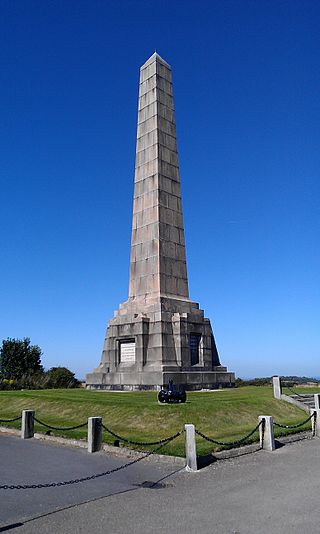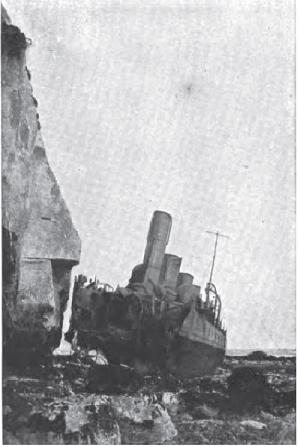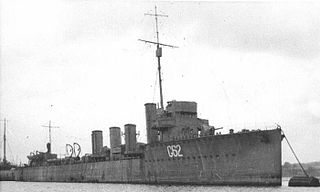Background
By the beginning of 1918 a deep mine barrage across the Dover Strait from Folkestone to Cape Gris Nez, on the French coast was in place. The Germans didn't know of its existence as any U-boats that came across it were destroyed. [2] The minefield worked in combination with a squadron of Royal Navy trawlers who, upon sighting a submarine, would drive it into the minefield by means of gunfire and flares. Between 18 December 1917 and 9 February 1918, five German submarines had been sunk in the minefield. [A 1] The Germans didn't know about the minefield and thought the Royal Navy ships were sinking the submarines. The Imperial German Naval command decided to send a Destroyer unit to attack the Royal Navy ships. [2]
The British had a light cruiser and three destroyers in the Downs, two destroyers on the West Barrage Patrol, four destroyers on the East Barrage Patrol and two paddle minesweepers, a monitor, a destroyer, a Patrol boat, two French torpedo boats and 10 trawlers supporting the 58 drifters patrolling the deep minefield. There should have been a monitor with 12 or 15 inch guns on duty but none was available so the 7.5 inch gunned HMS M26 was on duty. [3]
Action
British forces in the Channel sighted a submarine around 1:00 AM on 15 February 1918. As drifters attempted to force the submarine into the minefield in the usual manner, they were attacked by a force of German destroyers. The German ships appeared to use one destroyer to illuminate the target with a searchlight long enough for the other ships to get the range at which point the entire group would fire. The German destroyers enjoyed a considerable advantage in firepower over the smaller and scattered enemy craft and moved from one British vessel to the next, destroying each in turn.
In a similar fashion the Violet May was attacked and heavily damaged. Two Enginemen, Ewing and Noble, were able to launch a boat and row to safety. When the Germans left, they rowed back and re-boarded their burning ship, treated wounded and brought the fires under control, thus saving their ship. When dawn broke the drifter Courage towed them to Dover. The two engineers each were awarded the Conspicuous Gallantry Medal. [2]

The Dover Patrol and later known as the Dover Patrol Force was a Royal Navy command of the First World War, notable for its involvement in the Zeebrugge Raid on 22 April 1918. The Dover Patrol formed a discrete unit of the Royal Navy based at Dover and Dunkirk for the duration of the First World War. Its primary task was to prevent enemy German shipping—chiefly submarines—from entering the English Channel en route to the Atlantic Ocean, thereby obliging the Imperial German Navy to travel via the much longer route around Scotland which was itself covered by the Northern Patrol.

SMS S36 was a 1913 Type Large Torpedo Boat of the Imperial German Navy during World War I, and the 12th ship of her class. She was equipped with of three single mounted 8.8 cm SK L/45 naval guns and with six 50 cm (19.7 in) torpedo tubes, two forward and four aft; twenty-four mines could also be carried. She was launched on 17 October 1914 and commissioned on 4 January 1915. S36 took part in the Battle of the Gulf of Riga in 1915 and the Battle of Jutland in 1916. In late 1916 she served in the English Channel and took part in a number of engagements, including the Battle of Dover Strait during which a British merchant ship and a destroyer were sunk by her Half-Flotilla. She was scuttled at Scapa Flow in 1919.

SM U-17 or U-XVII was a U-10-class submarine or U-boat of the Austro-Hungarian Navy during World War I. U-17 was laid down in Germany in April 1915 and shipped in sections by rail to Pola in August, where she was assembled. She was delivered to the Austro-Hungarian Navy at the end of September and commissioned in October 1915.

A naval drifter is a boat built along the lines of a commercial fishing drifter but fitted out for naval purposes. The use of naval drifters is paralleled by the use of naval trawlers.

The Action off Noordhinder Bank on 1 May 1915 was a naval engagement between four British naval trawlers, supported by a flotilla of four destroyers and a pair of German torpedo boats from the Flanders Flotilla. The action began when the two torpedo boats were sent to rescue the crew of a reconnaissance seaplane that had been forced to alight by engine trouble and to attack the trawlers. The Germans engaged the trawlers; British destroyers from the Harwich Force appeared; the German ships tried to escape but were sunk.

The Battle of Dover Strait that occurred on 26–27 October 1916 was a naval battle of the First World War between Great Britain and the German Empire. Two and a half flotillas of German torpedo boats from the Flanders Flotilla launched a raid into the Dover Strait in an attempt to disrupt the Dover Barrage and destroy whatever Allied shipping could be found in the strait.

HMS Marksman was a Marksman-class flotilla leader of the British Royal Navy. Construction at Hawthorn Leslie's Newcastle upon Tyne shipyard began in 1914, shortly before the outbreak of the First World War, and the ship was launched and completed in 1915. She took part in the Battle of Jutland in 1916 and survived the war. She was sold for scrap in 1921.
HMS Murray was a Royal Navy Admiralty M-class destroyer. Ordered before the outbreak of war, she was therefore the first of her class to enter operation during the early months of the First World War. She was also the first vessel of the Royal Navy to carry the name HMS Murray.
SMS G96 was a large torpedo boat of the Imperial German Navy that was built and served during the First World War. She was the prototype ship of the 1916 Mobilisation Type torpedo boats, and was launched at Germaniawerft's Kiel shipyard on 19 September 1916, completing in December that year.

SMS V47 was a V25-class Large Torpedo Boat of the Imperial German Navy that was built and served during the First World War.
HMS Newbury was a Racecourse-class minesweeper of the British Royal Navy, built in 1916 by A. & J. Inglis. The Racecourse-class were paddle-steamers, intended for operations in shallow coastal waters.
HMS Lark was a Laforey-class destroyer of the British Royal Navy. The Laforey class was the class of destroyers ordered under the Royal Navy's 1912–1913 construction programme, which were armed with three 4-inch (102 mm) guns and four torpedo tubes and were capable of 29 knots. The ship, which was originally to be named Haughty but was renamed before launch, was built by the Scottish shipbuilder Yarrow between 1912 and 1913.

HMS Matchless was a Royal Navy Admiralty M-class destroyer. Matchless was built by Swan Hunter from 1913 to 1914 and was completed in December that year. She served through the remainder of the First World War, operating in the North Sea as part of the Harwich Force in the early part of the war and later in the English Channel as part of the Dover Patrol, where she took part in both the First and Second Ostend Raids. Despite being badly damaged by a German mine in 1915 and being involved in several collisions, she survived the war, and was sold for scrap in 1921.
SMS S34 was a V25-class large torpedo boat of the Imperial German Navy that served during the First World War. She was built by the Schichau-Werke shipyard in Elbing, East Prussia in 1913–1914 and was completed in being launched on 4 April 1914 and was completed in November 1914.
SMS V26 was a V25-class torpedo boat of the Imperial German Navy that served during the First World War. The ship was built by AG Vulcan at Stettin in Prussia, and was completed in June 1914.
HMS Melpomene was a Medea-class destroyer of the British Royal Navy. She was one of four destroyers, of similar design to the British M-class ordered by Greece in June 1914, which the British purchased during construction owing to the outbreak of the First World War.

SMS G102 was a G101-class large torpedo boat operated by Imperial German Navy during the First World War. The ship was ordered for the Argentine Navy from the German shipyard Germaniawerft as the San Luis, but was still under construction at the start of the war and was seized by Germany.
SMS V28 was a V25-class torpedo boat of the Imperial German Navy that served during the First World War. The ship was built by AG Vulcan at Stettin in Prussia, and was completed in September 1914. The ship took part in the Battle of Dogger Bank, the Battle of the Gulf of Riga in 1915, and the Battle of Jutland on 31 May 1916.
SMS V30 was a V25-class torpedo boat of the Imperial German Navy that served during the First World War. The ship was built by AG Vulcan at Stettin in Prussia, and was completed in November 1914.

HMS Lawford was a Laforey-class destroyer of the British Royal Navy. The Laforey class was the class of destroyers ordered under the Royal Navy's 1912–1913 construction programme, which were armed with three 4-inch (102 mm) guns and four torpedo tubes and were capable of 29 knots. The ship, which was originally to be named Ivanhoe but was renamed before launch, was built by the Scottish shipbuilder Fairfields between 1912 and 1914.











